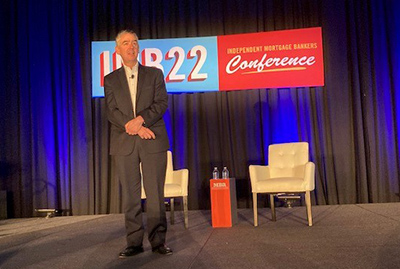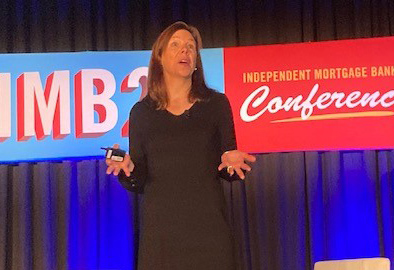
A More Challenging Economic Environment for IMBs

(MBA Chief Economist Mike Fratantoni speaks at the MBA Independent Mortgage Bankers Conference in Nashville Jan. 25.)
NASHVILLE, Tenn.—The nation’s economy—and just as importantly, the housing market—are as challenging and as opportunistic in any time in history, according to Mortgage Bankers Association economists.
“There is some tremendous uncertainty right now—whether it’s the situation with Russia and the Ukraine, and with inflation and other economic volatility,” said MBA Chief Economist Mike Fratantoni, presenting here at the MBA Independent Mortgage Bankers Conference. “The Federal Reserve is going to have to move much more quickly and much more forcefully than it did during the Great Recession.”
And given the reduction in mortgage volume in 2022—with the MBA forecast calling for the refinance share of mortgages to drop off more dramatically—“it’s going to require you to be more adaptable and resourceful,” Fratantoni said.
Inflation is running at the hottest rate in more than 40 years; MBA forecasts inflation to subside a bit, but still finishing 2022 at slightly more than 3 percent—still well above the 2 percent threshold set by the Federal Reserve.

MBA predicts three FOMC rate hikes in 2022. “The only question is when those hikes start to happen,” Fratantoni said. “We expect the Fed to announce the first rate hike to the federal funds rate in March—but we also expect them to go further—we think they will announce plans to shrink their balance sheet. They are probably going to have to shed $4 trillion in assets over the next couple of years.”
Jobs continue to be a bright spot in the economy—the current joblessness rate is 3.9 percent; the “Great Resignation” continues to manifest and there are currently more than 10 million job openings that remain unfilled.
“For job seekers, this is the best situation they are ever going to have—there are currently one and a half jobs for every job seeker,” Fratantoni said. “Tell your kids to get off the couch and get a job—the video games will still be there when they get home.”
After a record $4.1 trillion in mortgage volume in 2020, and a slight drop-off in 2021, Fratantoni said lenders should be prepared for a more dramatic drop-off in volume in 2022 and 2023 as refi volume falls off; the new MBA forecast calls for $2.6 trillion in origination volume in 2022 and $2.5 trillion in 2023—albeit with potential record purchase originations.
“For some of you, 2022 and 2023 will be as busy as ever,” he said. “For others, those years are going to be a very different environment.”
Coupled with this is demographic growth leading to “tremendous” future housing demand. “The biggest challenge has been the lack of inventory,” Fratantoni said. “The trick this spring is can we get enough new housing stock to attract move-up buyers and free up some housing for first-time home buyers…it’s headed in the right direction.”
As housing supply chain threats ease, Fratantoni said, home price appreciation should slow somewhat. “It looks like it’s crested a bit,” he said. “By the end of 2022, home prices will be increasing at more of a 5-6 percent rate. That is more sustainable.”
MBA Vice President of Industry Analysis Marina Walsh, CMB, noted IMBs have gained market share in the mortgage originations business for 12 consecutive years—and profitability remains above average.
“We’ve had a great ride for the past two years, but what goes up must come down over time,” Walsh said. “But compared to your peers on the deposit bank side, you’ve had much better results overall.”
Walsh said results from MBA’s quarterly Mortgage Bankers Performance Report showed not only have IMBs become more profitable in originating loans, they have also cut costs—which, in turn, has improved profitability.
However, in light of the MBA 2022 and 2023 forecasts, “We do expect those revenues to come down a bit,” Walsh cautioned.
And not only are IMBs increasing their purchasing share—they’re increasing their servicing share, too: according to the latest MBA National Delinquency Survey, IMBs now have 48% of the loan servicing market. And they are also starting to retain servicing. “A lot of sub-servicers were very, very busy in 2021,” Walsh said.
And along with servicing, IMBs are seeing value in mortgage debt outstanding, with the IMB share of MDO growing to nearly 13 percent. At the same time, Walsh said, the portion of delinquent loans have fallen by more than 300 basis points.
“You’re looking at a delinquency rate of about 5.3 percent,” Walsh said. “We’re not back to pre-COVID levels—but we were at 40-year lows before COVID.”
And forbearance levels are now below 700,000, Walsh said. “Servicers in general did a very good job of moving borrowers into workouts; there are a lot of good stories.”
